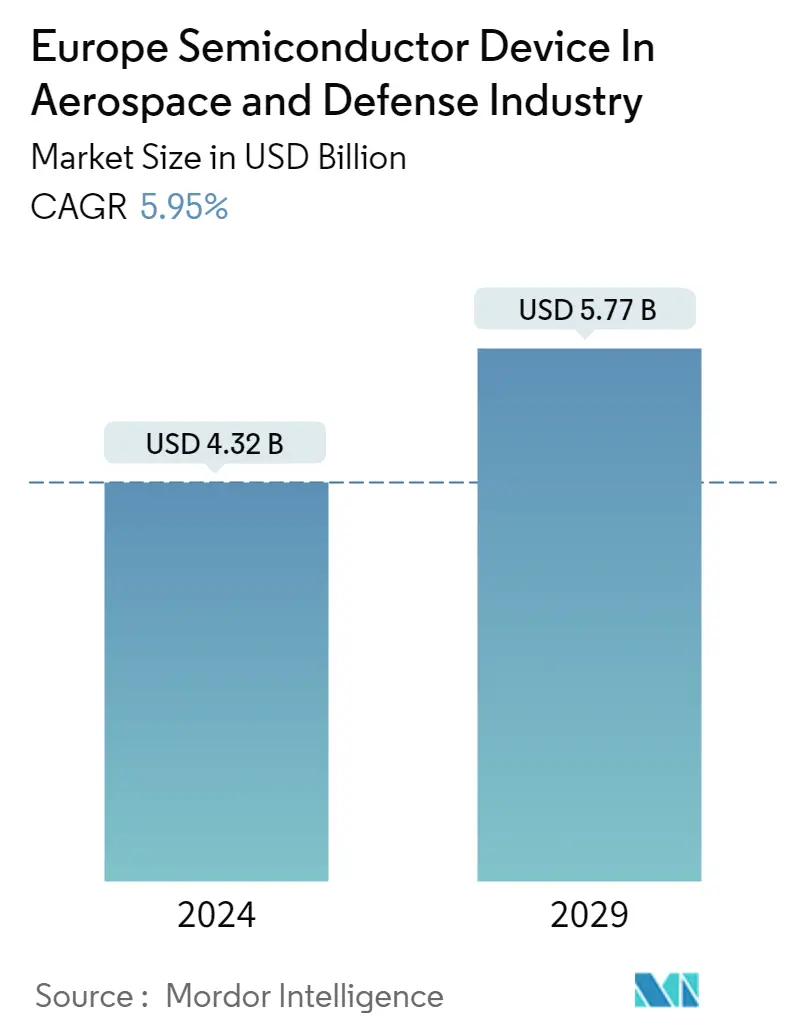Market Size of Europe Semiconductor Device In Aerospace & Defense Industry

| Study Period | 2019 - 2029 |
| Base Year For Estimation | 2023 |
| Market Size (2024) | USD 4.32 Billion |
| Market Size (2029) | USD 5.77 Billion |
| CAGR (2024 - 2029) | 5.95 % |
| Market Concentration | Medium |
Major Players*Disclaimer: Major Players sorted in no particular order |
Need a report that reflects how COVID-19 has impacted this market and its growth?
Europe Semiconductor Device in Aerospace & Defense Market Analysis
The Europe Semiconductor Device In Aerospace & Defense Industry is expected to grow from USD 4.32 billion in 2024 to USD 5.77 billion by 2029, at a CAGR of 5.95% during the forecast period (2024-2029).
- With increased military spending in Europe on developing the defense sector, there are plenty of opportunities for semiconductor device growth within the European defense and aerospace market.
- Semiconductors are utilized to produce a wide range of equipment and systems in the military and aerospace industries. As power electronics are widely used in aerospace and defense applications, such as power drive controls, landing gear and defensive aids systems (DAS), engine systems and controls, flight control, navigation, cabin lighting, avionics, and communications, there is a significant demand for power semiconductor devices in this industry.
- Europe aims to achieve strategic autonomy by 2033, according to the 2023 Global Strategy. As a result, the European Union (EU) countries have started a complex modernization program to increase their military strength. As a result, European countries are making significant investments in modernizing aerial capabilities to deal with a changing threat environment in the area fueled by geopolitical crises.
- However, the complexity of threats to global security has increased, and it is anticipated that the COVID-19 pandemic's economic fallout will force governments to make difficult decisions about their defense budgets that will significantly impact their short- and long-term military capabilities.
- Furthermore, Microchip Technology, working with European Commission consortium member Clean Sky, developed a family of SiC-based power modules for aerospace applications to enable more efficient and compact power conversion and engine drive systems. The modules use a mix of 1200V silicon carbide (SiC) MOSFETs and 1600V diodes on a modified substrate for harsh aviation applications.
- The importance of space as a market that can present opportunities for both developed and emerging countries has increased during the past ten years. Due to their ability to address global issues like the climate and biodiversity crises and the rising reliance of the EU economy and society on space infrastructure, services, and data, space policies and their applications have also risen in political prominence.
- To protect EU spatial ecosystems and maintain EU autonomy in space, EU space policy has two main objectives: to foster scientific and industrial competitiveness and to increasingly use space investments and services to address important EU political priorities like the European Green Deal and the Digital Decade. These emerging trends will propel the market growth during the forecast period.
